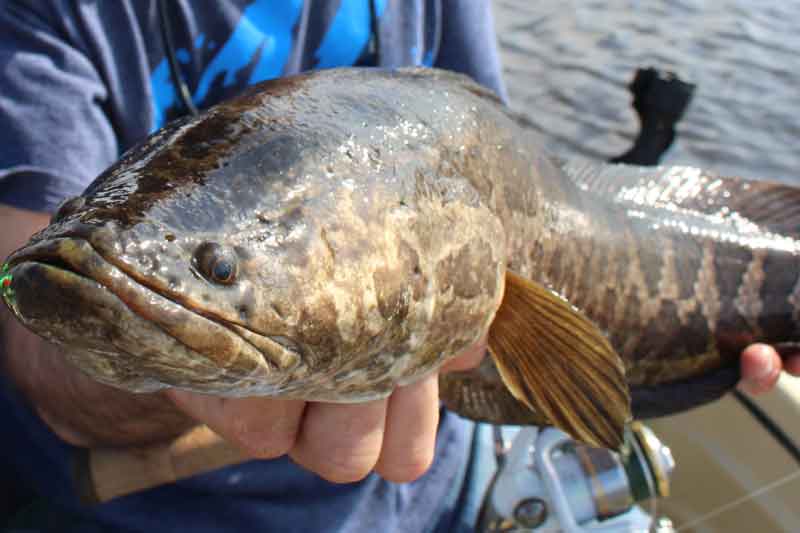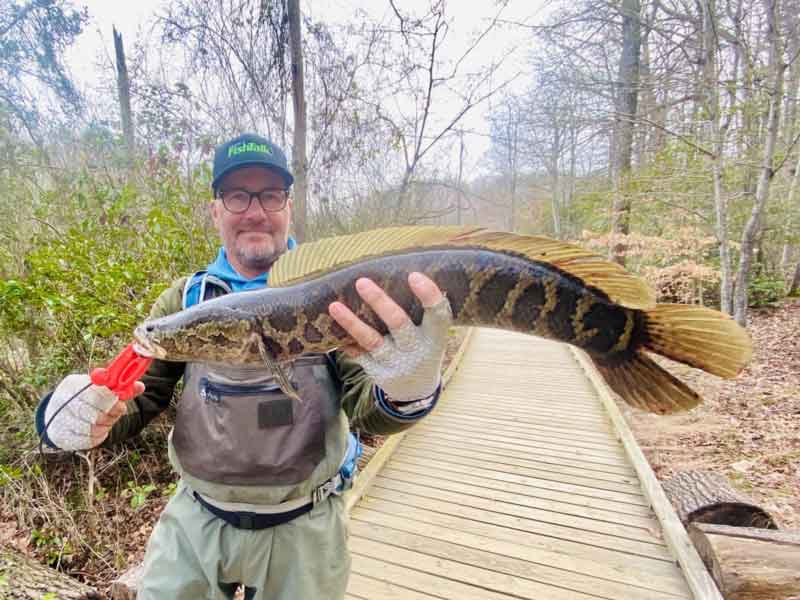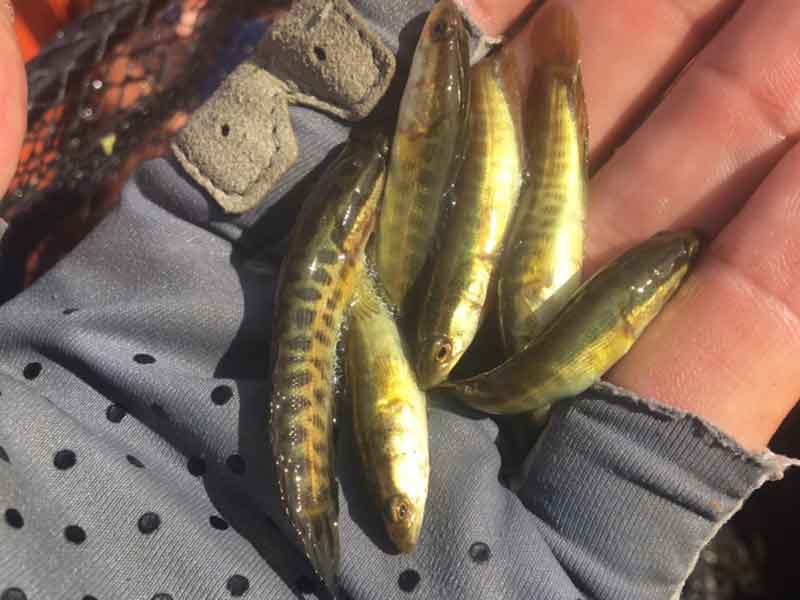What’s the biggest recent development in the world of fishing on the entire eastern seaboard? Quite possibly, the advent of the snakeheads. No, we aren’t happy that this invasive invader took root in our waterways, but it’s here to stay and there’s no better way to tamp down the populations than to focus on them while fishing. Added bonus: they taste absolutely fantastic. And ground-zero for the snakehead fishery is – quite literally – Maryland.

Snakeheads were first discovered on the East Coast in a small pond in Crofton, MD, and despite the authority’s efforts to eliminate them before they spread, soon began popping up in the Potomac’s waterways. In the following years they spread to virtually all the Chesapeake’s upriver tributaries as well as many other ponds and lakes, and have come to dominate the fisheries in several areas. In fact, today anglers travel to Maryland from up and down the coast to wet their lines in pursuit of snakeheads, and you shouldn’t be surprised to see license plates from New York, New Jersey, and North Carolina on the cars parked at boat ramps and access points well known for a hot snakehead bite.
Snakehead Fishing Tactics
One of the big draws of targeting snakeheads is the explosive blow-ups they provide when they strike. Often just before this attack you’ll spot the snakehead “waking” your lure, which occurs when they dart towards it with such speed and aggression that they create a wave on the water’s surface. It’s an awesome and exciting predatorial display that keeps many anglers casting topwater lures even at times when they may be less effective than other offerings. But now that the weather has warmed, topwater will be the number-one method of going after them in any case. In fact, in many waterways it’s virtually the only way to target them.
Snakeheads thrive in extremely shallow waters that are often clogged with vegetation. And in this environment lures that might otherwise be effective, like spinnerbaits, chatterbaits, swimbaits, or even live minnows, will become instantly fouled – only weedless topwater lures need apply. The number-one pick? Weedless frogs.
You have a huge number of weedless frogs to choose from, and truth be told, virtually all will work. Color choice is sometimes a big factor in just how many hits you’ll get, with white, yellow, and green being among the usual top picks. Depending on the water temperature and the fish’s aggression level a fast and relatively steady retrieve punctuated with jiggles of the rod tip, or a reel-pause-reel retrieve, may work best. In either case, when a snakehead goes nuclear on your little froggie you’ll have to stay calm through the adrenaline rush and hold back the instinctual hook-set. Wait for a second before applying pressure to allow the snakehead to get the lure all the way into its mouth, or you may jerk that lure away prematurely.
Following heavy rains and/or significant temperature drops, the snakeheads may transition to slightly deeper, more open waters for a period of time. This allows anglers the flexibility to use other types of lures, both topwater and sub-surface, as well as live bull minnow fished under a bobber (the undisputed snakehead champion during the chillier months of the year). Chatterbaits and spinnerbaits are favored by many, but truth be told, just about any offering you might use for bass has a good shot at being effective. Target areas should include the edges of weedbeds, structure, and shallow water transition areas (often of just a foot or two).
Fishing Gear for Snakeheads
Because these fish are so often caught in heavy, weedy cover, using stout gear is a must. While even the largest snakeheads found in Maryland waters don’t top 20 pounds – yet – as soon as they realize they’re hooked they often bury themselves in the vegetation and you can easily end up with well over 20 pounds of resistance on the end of your line. Thirty-pound braid line is considered minimal by most snakehead sharpies, and using 40-pound test is not uncommon.
Along with the heavy line you need a relatively heavy rod with a fast action for solid hook-sets, and the oomph to haul up a matt of weeds along with the fish. A six-foot, six-inch or seven-foot medium to medium heavy (either spinning or casting) rig is usually considered about right for targeting snakes in heavy cover.

Snakeheads differ from other species in that the fight doesn’t end once you have them in the boat or on the shore. They have the ability to breath out of the water, so they don’t quickly tire or become docile when you pull them out of it. In fact, they’re known for flipping out of nets, boats, and even coolers long after they’ve been caught. In order to get a firm grip on the situation, using a clamping lip-gripper is considered a must.
If you plan on taking any snakeheads home for dinner – these fish do taste truly phenomenal – a final piece of must-have gear for snakehead fishing in Maryland waterways is a sharp knife. While it is legal to catch and release a snakehead in the state of Maryland, it’s against the law to transport them live. And simply running a stringer clip through their gills or dropping them into a cooler won’t result in their demise, as these are amazingly hearty fish. So snakeheads have to be intentionally dispatched by cutting the gills away from the body, removing the head, or otherwise ensuring that they can’t live once in your possession.
Looking for a reason to hit the road and embark on a new fishing adventure? If you haven’t tried snakehead fishing yet, you’re missing out in a big way – now’s the time to plan out a trip and come play with some space invaders.
Five Free State Snakehead Hotspots
Ready to head for some of Maryland’s best snake spots? As we mentioned earlier these fish are now found in virtually all freshwater tributaries of the Chesapeake, but these five locations are top-notch bets.
1. The Blackwater Complex – The Blackwater River, the Little Blackwater, and the associated waterways are without a doubt some of the best snakehead-hunting territories on the face of the planet. In much of these waters maximum depth is just a foot or two and sticking with weedless topwater is usually the best bet, though at the Key Wallace causeway there’s open water and a wider range of offerings can often be presented. There are numerous access points where you can fish from the shoreline and/or bridges, multiple kayak soft-launches, and boat ramp facilities as well. Visit the US Fish & Wildlife Blackwater webpage to check up on the current rules, regulations, and access areas inside the refuge itself.
Tips for Traveling Anglers: Cambridge, MD, offers the closest lodging and restaurant facilities to the Blackwater area. Many of the local hardware or convenience stores have basic tackle supplies and there are some “big box” stores in both Cambridge and nearby Easton, as well. But out-of-towners should remember one thing: if you come to this part of Maryland during the summer, go to a restaurant for dinner, and if you don’t try the local crab cakes, you’re missing out big-time!
2. Lower Shore Rivers – The lower Eastern Shore rivers feeding the Tangier Sound, including the likes of the Transquaking, Chicamacomico, Nanticoke, and Marshyhope, are all solid snakehead territory. This is an area where “bridge hopping” is popular among shoreline anglers, who drive from bridge to bridge to try several different rivers on the same outing. When bridge hopping remember to park your vehicle only in appropriate areas and completely off the road, carry out all your trash, and if you’re fishing at a pier or ramp give way to anglers launching and retrieving boats. Boat and kayak anglers will commonly work shorelines and weedy pockets away from the crowd.
Tips for Traveling Anglers: Salisbury, MD, is an excellent jumping-off point for snakehead trips in this zone, and has just about all forms of accommodations and services. When planning a trip here we’d strongly recommend visiting the Maryland DNR’s Online Water Access Guide at their website (dnr.maryland.gov). Here you can find an interactive map to all of the boat ramps on these rivers (as well as everywhere in the state) that includes information like permit requirements (where applicable), what facilities or services are available, ramp size, and hours of operation.
3. Creeks of the Potomac – The Maryland state record snakehead of 19.9 pounds was skewered in Mattawoman Creek. That fish even beat the IGFA world record (topping it by over two pounds) but didn’t qualify because it was captured bow fishing, not on hook and line. So it seems like a good bet there’s a new world record snakehead swimming around in Maryland waters, right now! Some of the other creeks known for big snake potential include Mallows Bay and Nanjemoy, both of which also have access areas including boat ramps and kayak launches. In all of these creeks, you’ll commonly do best if you head upriver and fish shorelines and weedy areas, as opposed to open waters closer to the river itself. Added bonus: you can also expect to encounter plenty of bass in these areas.
Tips for Traveling Anglers: La Plata and Waldorf offer travelers all the amenities they need. While you’re in the area, however, note that you’re also close to Patuxent River Park, including Jackson’s Landing and Jug Bay. While these waters aren’t famous for their snakeheads there are plenty of snakes in them, but more importantly this area is renowned for its wildlife, bird watching, and 19 miles of trails – it’s well worth visiting, before, after, or during your quest to put some snakes in the cooler.
4. The Gunpowder River – During the past couple of years tidal areas of the Gunpowder have emerged as one of the newer snakehead hotspots in Maryland, and as the Bay waters have low salinity this far north, even lower-river areas like Gunpowder Falls State Park provide opportunities for shoreline anglers. They can also shoot for snakes on the north side of the river, at Joppatowne Park. Boaters can put in at Mariner Point. Most of the areas here are less weed-choked than some other top snakehead spots, so a wider range of lures and techniques can be applied and fishing minnow under a bobber is always considered a good bet.
Tips for Traveling Anglers: Close access to I-95 means that getting here is easy from just about anywhere, and hotels and restaurants are available in nearby White Marsh, Aberdeen, and many areas in-between. Fishing here also puts you in close proximity of the stretch of the Gunpowder between Loch Raven Reservoir and the snake-zone, which is well worth visiting for trout and smallmouth bass fishing. Or take a short trip up to the tailwater section between Prettyboy and Loch Raven and try some trout fishing along the Lefty Kreh Fishing Trail, dedicated to the world-famous angler, author, and Maryland native.
5. The Susquehanna River – Another relative newcomer to the list, the snakehead population in the lower river has exploded over the past few years. While it’s not likely to produce trophy-sized fish just yet, fishing here can result in serious numbers. Like the Gunpowder it’s often possible to find snakeheads in more open waters including up on the Susquehanna Flats. Many anglers run boats up into the North East River which also supports a large snakehead population, and these waters are favored for bow fishing opportunities as well. (Boat launching can be found at Lapidum, Port Deposit, and Havre de Grace).
Tips for Traveling Anglers: There’s some lodging at Havre de Grace with many more choices in Aberdeen, plus plenty of restaurants in the area. But another opportunity that’s not to be missed in this corner of Maryland is the world-class catfish fishery just a short run upriver. Blue catfish and channel cats swarm in the vicinity of the I-95 bridge, and if you head upriver from there you’ll start encountering flatheads as well. Put cut baits on bottom in these stretches of the river and nonstop action is the norm.

Sign up here to get the weekly FishTalk Chesapeake Bay and Mid-Atlantic fishing reports in your email inbox, every Friday by noon.